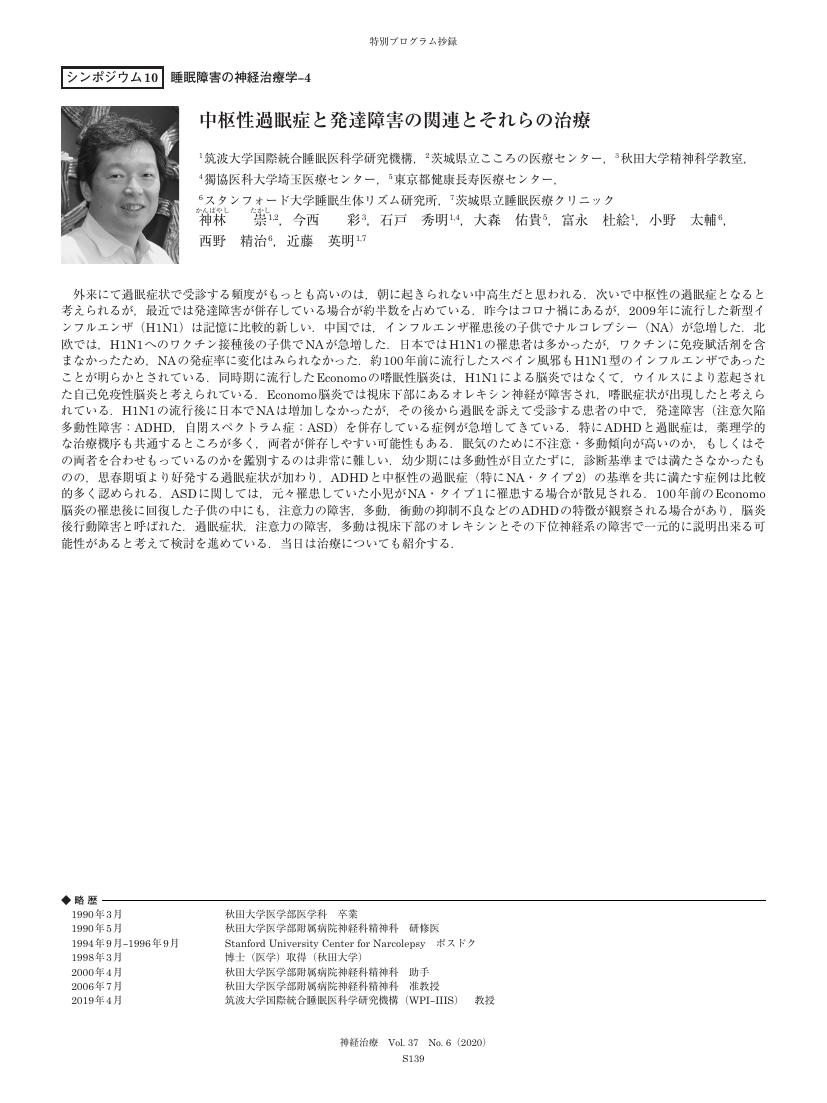34 0 0 0 OA 夜間睡眠の延長と睡眠相後退症候群に対するaripiprazoleの有効性の検討
- 著者
- 神林 崇 大森 佑貴 今西 彩 高木 学 佐川 洋平 筒井 幸 竹島 正浩 小野 太輔 塩見 利明 清水 徹男
- 出版者
- 日本神経治療学会
- 雑誌
- 神経治療学 (ISSN:09168443)
- 巻号頁・発行日
- vol.34, no.4, pp.406-410, 2018 (Released:2018-02-20)
- 参考文献数
- 6
Delayed sleep phase disorder (DSPD) comprises a persistent or recurrent pattern of sleep disturbances, sleep disruption that leads to insomnia and/or excessive daytime sleepiness, and impaired functioning in social, occupational, or other spheres. Three techniques are typically used to treat DSPD : chronotherapy, phototherapy, and exogenous melatonin administration. Antipsychotics have not been reported in the treatment of DSPD, aripiprazole (APZ), which is a second generation antipsychotic, manifests a novel mechanism of action by serving as a partial agonist of D2 receptors. Depression is reported to be the most common psychopathology associated with DSPD, and APZ is reported to be effective in major depressive disorder as adjunctive therapy. Therefore, we speculated that APZ might be effective to treat DSPD, and we observed how APZ works for the treatment of DSPD.Methods : 18 subjects (including 7 women) who are 14–48–year–old (the average is 31.6) were included. The patients were prescribed 0.75–4.5mg APZ at once a day.Results : We prescribed 1.5–3.0mg/day of APZ, all subject reduced total sleep time (9.6 +/− 2.3h → 7.8 +/− 2.0h, p=0.03), many cases got up earlier (9.1 +/− 1.9h → 6.7 +/− 1.4h, p=0.005) in the morning and advanced their sleep phase within one week. The sleep onset was not significantly changed (23.5 +/− 2.0h → 22.9 +/− 1.9h, n.s.).Conclusion : Low dose of APZ would reduce nocturnal sleep time in the subjects who had prolonged sleep time and DSPD symptoms. The mechanism of action would be dopaminergic up regulation due to dopamine D3 agonistic activity. Since it is difficult for physicians to treat prolonged sleep time and DSPD symptoms, this medication would become a new therapeutic tool for these patients.
- 著者
- 神林 崇 今西 彩 富永 杜絵 石戸 秀明 入鹿山 容子 韓 庫銀 木村 昌由美 近藤 英明
- 出版者
- 日本神経治療学会
- 雑誌
- 神経治療学 (ISSN:09168443)
- 巻号頁・発行日
- vol.38, no.4, pp.503-507, 2021 (Released:2022-04-28)
- 参考文献数
- 7
Even though we are currently in the midst of pandemic from coronavirus infection, the new influenza (H1N1) epidemic in 2009–2010 was unforgettable. Concurrently with the H1N1, narcolepsy surged in post–affected children in China. In Northern Europe, narcolepsy surged in children after H1N1 vaccination. Although there were many cases of H1N1 in Japan, there was no change in the incidence of narcolepsy because anti–influenza drugs prevented the disease from becoming more severe and the vaccine did not contain an adjuvant. It has recently become clear that the Spanish flu that prevailed about 100 years ago was also H1N1. Economo's encephalitis lethargica, which was prevalent at the same time, is thought to be autoimmune encephalitis rather than H1N1–induced influenza encephalitis. It has been reported that Economo's encephalitis caused damage to the hypothalamus, including the orexin system, resulting in lethargic symptoms.Since the 2010s, the number of patients with neurodevelopmental disorders (ADHD, ASD) has been increasing among the patients who complain of hypersomnolence. Consideration of the course of symptoms revealed that the patient was originally below the threshold of the diagnostic criteria for neurodevelopmental disease, that hypersomnolence occurred from around adolescence, and that the case also met the criteria for neurodevelopmental disease. Although hypersomnolence was not noticeable in early childhood and inattention was the main symptom, the diagnostic criteria were not met. Hypersomnolence, on the other hand, increased from around adolescence, was added, and attention deficit was exacerbated. Therefore, it is considered that there are many cases that satisfy both the diagnosis of ADHD and central hypersomnia. ADHD characteristics such as attention deficit, hyperactivity, and poor impulsivity may be observed in children who have recovered from Economo's encephalitis and are called post–encephalitis behavioral disorders. The pathophysiology of Economo's encephalitis is presumed to be a disorder of the hypothalamus, including the orexin system, but it is possible that the disorder remained even after recovery.We believe that impaired attention, and restlessness caused by the hypersomnolence in neurodevelopmental disorders can be explained by dysfunctions of the orexin system and its arousal system. H1N1 morbidity may trigger neurodevelopmental disorders accompanied by hypersomnolence.

